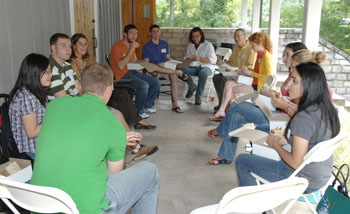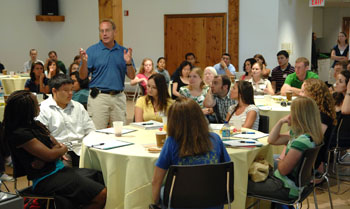
Incoming biomedical graduate students relax during last week’s orientation at the Travellers Rest Plantation and Museum. (photo by Neil Brake)
Biomedical graduate program’s incoming group is largest ever

James Patton, Ph.D., standing, talks with incoming graduate students at last week’s orientation. (photo by Neil Brake)
Vanderbilt's newest biomedical graduate students stepped back in time before stepping forward into their studies. Last week's orientation activities were held at the historic Travellers Rest Plantation and Museum in Nashville.
The new student group is the largest ever for the Interdisciplinary Graduate Program (IGP), which welcomed 87 students. The Chemical and Physical Biology (CPB) Program enrolled eight students, and four students are part of the IMSD (Initiative for Maximizing Student Diversity) program.
The increase in numbers and the caliber of the incoming students reflect Vanderbilt's growing national and international stature as a top research institution, said James Patton, Ph.D., director of the IGP.
This year's group also includes more international students than previous classes, with 17 students who are non-U.S. citizens or permanent residents. Overall, the students hail from 29 states and five countries and graduated from 73 different colleges and universities. The group is 52 percent female.
“We're pleased to see students coming to Vanderbilt from top U.S. and international institutions,” Patton said.
In addition to Vanderbilt's increasingly positive reputation, it is one of only a handful of institutions that allows biomedical graduate students to choose from a smorgasbord of research options that span many departments and programs.
“Students repeatedly cite the number of different labs and research opportunities as one of the key reasons they choose Vanderbilt,” said Michelle Grundy, Ph.D., assistant director of Graduate Programs in Biomedical Sciences.
The core curriculum for incoming students is being fine-tuned this year to include a stronger emphasis on small group literature discussions with a focus on how to do scientific research.
“Learning how to read the primary literature is a fundamental skill students learn in graduate school, and given the size of this incoming class, the small group discussions will give students the opportunity to connect personally with faculty members and their classmates,” Grundy said.
The IGP recruits and educates graduate students who are interested in biological and biomedical research. The CPB program is aimed at students with a quantitative sciences background who wish to pursue research in areas that span the boundaries of the chemical, physical and biological sciences.
Both programs organize the training — coursework and laboratory rotations — of students during their first year at Vanderbilt. At the end of the first year, students choose mentors and home departments or programs where they complete their coursework and doctoral dissertation research.
For more information about biomedical research education and training at Vanderbilt, go to http://bret.mc.vanderbilt.edu/bret/.













